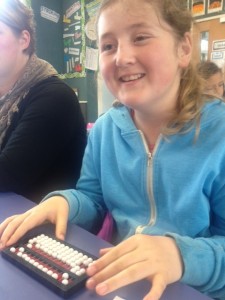Shannon is 10 years old and is currently attending her local primary school and transitioning to intermediate for 2013.
She participates in Practical Maths mornings which are planned by the BLENNZ Wellington team at least once a term, to provide concentrated sessions for braille learners on practical aspects of the New Zealand Maths Curriculum.
Topics covered include abacus skills, practical geometry, reading and creating diagrams and graphs. In figure 1 Shannon is doing subtraction using the Cranmer Abacus.
Using the abacus to consolidate place value skills
Abacus skills, as a computation strategy, are an important part of the learner’s “toolkit” and must be thoroughly taught, as they are the braille student’s equivalent of the ‘pencil and paper’.
Shannon is practising subtraction of three-digit numbers – the subtrahend (number to be subtracted from the minuend) is set on the extreme left of the abacus as a ‘reminder’ as the subtraction takes place on the extreme right.
Place value is a very important concept and is reinforced in this activity. In figure 2 Shannon is setting the minuend and subtrahend.
Prerequisite skills
This learner:
- Knows the basics of arithmetic operations.
- Understands the concept of subtraction (taking away, less than, minus).
- Has mastered addition on the abacus and simple subtractions.
- Has a good understanding of place value.
- Consistently labels the columns correctly.
- Can ‘set’ and ‘clear’ numbers using correct fingering.
In figure 3 Shannon is working through the algorithm.
Where to next for Shannon
- Four-digit subtractions.
- Five and six-digit subtraction.
- Multiplication on the abacus.
- Division on the abacus.
Teaching methods and strategies
- A planned approach to the introduction of the abacus.
- Regular practice in class.
- Ensuring the teacher aide was trained in basic abacus skills.
Learning adaptations
- Purchase of a Cranmer Abacus for the learner to have at school.
- Enrolling the teacher aide in the Hadley School Abacus programme.
Assessment
Assessment tools and strategies:
- Self-assessment at the end of each lesson by each student.
- Evidence of successful computation.
Professional Readings and Resources
- Applications of the abacus for the blind – Learn Abacus at AbacusLessons.com.
- Abacus: Websites, Books & Games – The Hadley School for the Blind.
- Project Math Access: The Abacus – Texas School for the Blind and Visually Impaired.
- Cranmer Abacus Podcast Series – Brooklyn Avenue School.
- Making math accessible for the blind – squareCircleZ.
Learning resources
- The Cranmer Abacus (resource booklet produced by BLENNZ).
More information
Email us at BLENNZ for more information about this subject.
We will link you up with either the author of this post or another BLENNZ colleague with whom you can continue your conversation.



